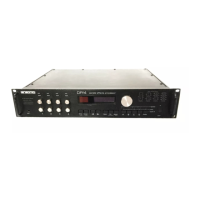Section 2 — Algorithms
64 ENSONIQ DP/4+ Reference Manual
MULTI TAP DELAY
MultiTap Delay produces four independent controllable delays. This algorithm requires only
one unit, allowing the other three units to be free for other algorithms.
01 — Mix
02 — Volume
See the descriptions under the Mix and Volume Parameters, in the beginning of this section. This
algorithm sounds best with a Mix of wet and dry.
03 — MultiTap 1 Time
07 — MultiTap 2 Time
11 — MultiTap 3 Time
15 — MultiTap 4 Time Ranges: 0 to 1834 ms
These four parameters set the amount of delay time for the independent delays. Experiment with
the different settings to find the right mix for your sound source and application. Some
interesting effects can be created by using a real time modulation controller for these parameters.
04 — MultiTap 1 Level
08 — MultiTap 2 Level
12 — MultiTap 3 Level
16 — MultiTap 4 Level Ranges: 00 to 99
These four parameters adjust the volume of the delayed signals against the original dry signal.
Levels of 00 will offer no audible delay.
05 — MultiTap 1 Regen
09 — MultiTap 2 Regen
13 — MultiTap 3 Regen
17 — MultiTap 4 Regen Ranges: 00 to 99
These parameters determine the amount of signal that will be fed from the output back into the
input, increasing the number of repeats in the delays. A setting of 99 would offer an infinite delay.
06 — MultiTap 1 Pan
10 — MultiTap 2 Pan
14 — MultiTap 3 Pan
18 — MultiTap 4 Pan Ranges: -99 to +99
These parameters determine the location of the four controllable delays in the stereo spectrum. A
value of -99 is panned far left, and +99 is far right.
19 — Regen Damping Ranges: 00 to 99
Controls the cutoff of a low pass filter on the feedback signal, which adjusts the amount of
damping to the feedback signals. The higher the number, the more the signals are damped.
20 — Mod1 Source 24 — Mod2 Source
21 — Mod1 Destination 25 — Mod2 Destination
22 — Mod1 Param Range Min 26 — Mod2 Param Range Min
23 — Mod1 Param Range Max27 — Mod2 Param Range Max
See the descriptions under the Algorithm Modulators, in the beginning of this section.
NO EFFECT (BYPASS EFFECT)

